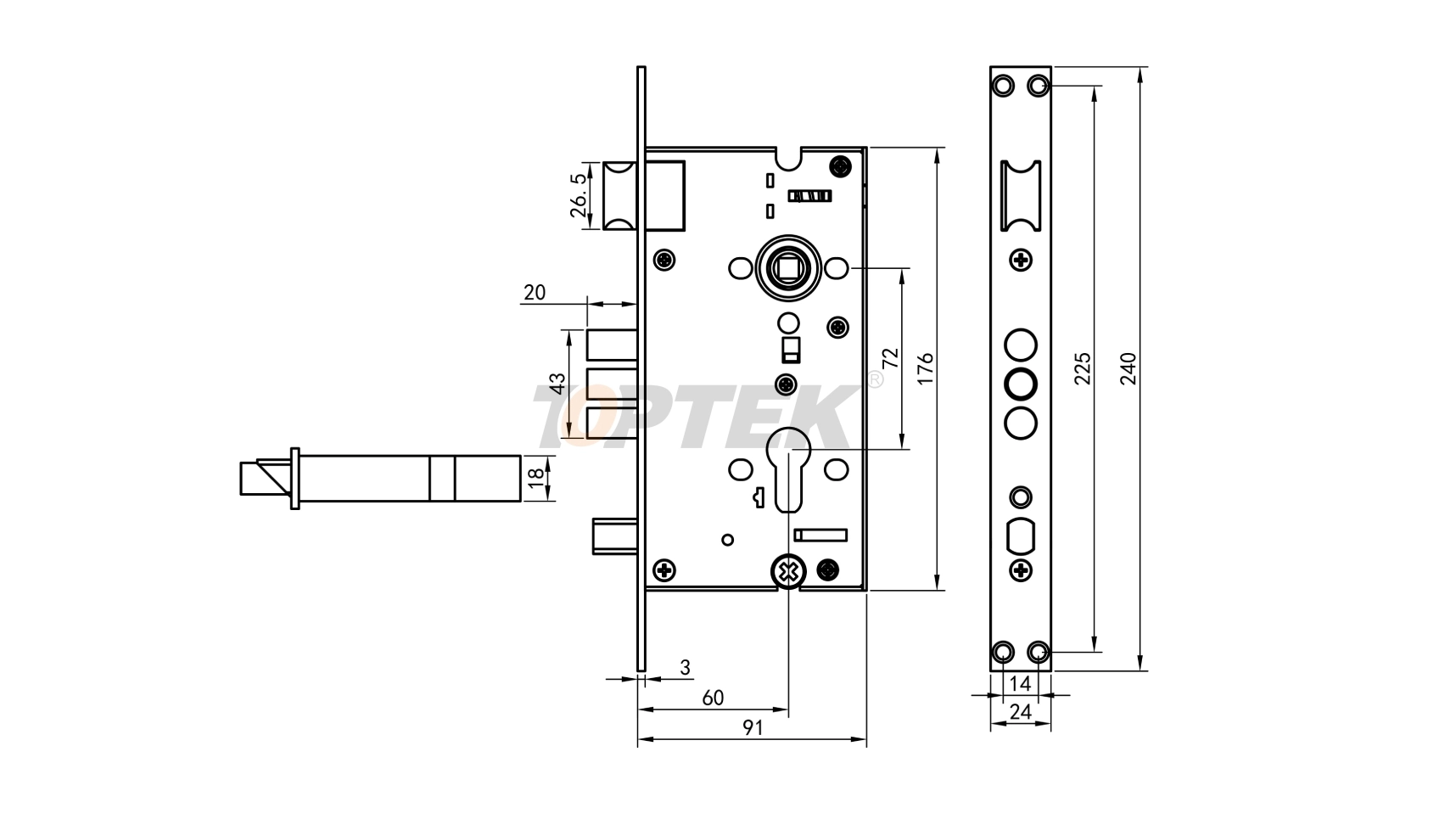Choosing the right commercial door lock can make the difference between a secure business and a vulnerable one. Business owners face countless security decisions, but few are as fundamental as selecting locks that meet appropriate ANSI standards while fitting their budget and operational needs.
The American National Standards Institute (ANSI) has established clear grading systems that help business owners understand exactly what level of security and durability they're purchasing. ANSI door lock ratings provide objective benchmarks for performance, taking the guesswork out of commercial security investments.
Understanding the differences between Grade 2 and Grade 3 locks empowers you to make informed decisions that protect your assets without overspending on unnecessary features. This guide examines both options in detail, helping you determine which grade best serves your specific business requirements.
ANSI Door Lock Standards
The ANSI/BHMA (Builders Hardware Manufacturers Association) grading system evaluates locks across three critical performance areas: security, durability, and finish quality. Each grade represents progressively higher standards, with Grade 1 offering the highest performance and Grade 3 providing basic commercial functionality.
These standards emerged from industry recognition that businesses needed reliable ways to compare lock performance across different manufacturers. Rather than relying on marketing claims or subjective assessments, ANSI grades provide measurable, tested performance criteria that ensure consistency across the industry.
Testing protocols evaluate locks through rigorous cycles that simulate years of real-world use. Locks must pass strength tests, endurance cycles, and security evaluations to earn their grade designation. This comprehensive approach means business owners can trust ANSI ratings as accurate representations of long-term performance.
The grading system also considers operational smoothness, key durability, and resistance to various attack methods. These factors combine to create a holistic assessment that reflects how locks will perform in actual business environments over extended periods.
ANSI Grade 2 Locks: Balanced Performance
Grade 2 locks strike an optimal balance between security, durability, and cost-effectiveness for most commercial applications. These locks undergo testing that includes 400,000 operational cycles, demonstrating their ability to withstand moderate to heavy daily use without performance degradation.
Security testing for Grade 2 locks includes resistance to 540 inch-pounds of torque applied to the lever or knob. This standard ensures the lock can resist common forced entry attempts while maintaining smooth operation under normal use conditions. The cylinder must also withstand specific picking and drilling tests that simulate real-world attack scenarios.
Durability extends beyond just the mechanical components. Grade 2 locks must pass rigorous finish testing that simulates years of environmental exposure, ensuring they maintain their appearance and corrosion resistance throughout their service life. This attention to finish quality makes Grade 2 locks suitable for customer-facing applications where appearance matters.
The operational smoothness requirements for Grade 2 locks ensure consistent performance across the full range of environmental conditions typically encountered in commercial buildings. Temperature variations, humidity changes, and normal wear patterns won't significantly impact lock function when properly maintained.
ANSI Grade 3 Locks: Essential Commercial Protection
Grade 3 locks provide fundamental commercial security features at entry-level pricing, making them suitable for applications where basic protection meets operational requirements. These locks must complete 200,000 operational cycles during testing, demonstrating adequate durability for light to moderate commercial use.
The security standards for Grade 3 locks require resistance to 270 inch-pounds of applied torque, providing reasonable protection against casual tampering while maintaining affordability. While this represents half the resistance of Grade 2 locks, it still exceeds residential standards and offers meaningful commercial protection.
Finish testing for Grade 3 locks ensures basic corrosion resistance and appearance retention suitable for interior applications or protected exterior installations. The standards focus on functional performance rather than premium aesthetics, reflecting the cost-conscious nature of many Grade 3 applications.
Installation flexibility represents another advantage of Grade 3 locks. Their straightforward design often allows for easier retrofitting in existing door preparations, reducing installation costs and complexity compared to higher-grade alternatives.

Security Performance Comparison
The security differences between Grade 2 and Grade 3 locks become apparent when examining their resistance to various attack methods. Grade 2 locks must withstand significantly higher torque forces, making them more resistant to lever attacks and forced entry attempts using common tools.
Cylinder security varies between grades as well. Grade 2 cylinders typically feature enhanced pin configurations and improved resistance to picking, bumping, and drilling attacks. These features provide meaningful security advantages in environments where sophisticated attack methods might be employed.
Strike plate requirements differ substantially between grades. Grade 2 installations often specify heavier gauge strike plates with longer screws, creating stronger door frame connections that resist kick-in attempts more effectively than standard Grade 3 installations.
Key control options expand with Grade 2 locks, offering features like restricted keyways and patented key profiles that prevent unauthorized key duplication. Grade 3 locks typically use standard keyways that offer basic key control but may not provide the same level of key security for sensitive applications.
Durability and Longevity Factors
The operational cycle testing reveals significant durability differences between Grade 2 and Grade 3 locks. Grade 2 locks' 400,000-cycle requirement translates to years of additional service life in high-traffic applications, potentially doubling the replacement interval compared to Grade 3 alternatives.
Component quality varies substantially between grades. Grade 2 locks typically feature heavier gauge materials, improved bearing surfaces, and enhanced spring mechanisms that maintain consistent performance over extended periods. These improvements directly translate to reduced maintenance requirements and lower long-term costs.
Environmental resistance capabilities differ between grades as well. Grade 2 locks often include enhanced sealing and corrosion-resistant treatments that allow installation in more challenging environments without performance degradation. This expanded application range increases their versatility for diverse commercial settings.
Warranty coverage frequently reflects the durability differences between grades. Manufacturers typically offer longer warranty periods for Grade 2 locks, demonstrating their confidence in the superior construction and materials used in these products.
Cost Analysis and Value Considerations
Initial purchase prices for Grade 2 locks typically exceed Grade 3 options by 30 to 50 percent, but this upfront investment often provides superior long-term value through extended service life and reduced maintenance requirements. The total cost of ownership calculation should include installation, maintenance, and replacement costs over the lock's expected lifespan.
Labor costs remain relatively similar between grades, as installation procedures don't vary significantly. However, the extended service life of Grade 2 locks reduces the frequency of replacement labor, creating additional savings over time. This factor becomes particularly important in high-labor-cost markets.
Maintenance intervals differ between grades due to their construction quality differences. Grade 2 locks typically require less frequent adjustment and lubrication, reducing ongoing maintenance costs while improving reliability. These operational savings accumulate over the lock's service life.
Security breach costs provide another economic consideration. The enhanced security features of Grade 2 locks may prevent break-ins that could result in inventory loss, property damage, and business interruption costs that far exceed the price difference between lock grades.
Application-Specific Recommendations
High-traffic commercial entrances benefit significantly from Grade 2 locks due to their enhanced durability and smooth operation under heavy use. The additional operational cycles ensure consistent performance despite frequent use, while the improved security features provide appropriate protection for main entrances.
Interior office doors in low-security applications may function adequately with Grade 3 locks, particularly when budget constraints limit options. However, consider the long-term replacement costs when making this decision, as the durability difference may justify the Grade 2 investment even in lower-traffic applications.
Retail environments typically warrant Grade 2 locks due to the combination of high traffic, security requirements, and customer visibility. The enhanced finish durability and operational smoothness create better customer impressions while providing appropriate security for commercial retail applications.
Storage areas and utility rooms may function acceptably with Grade 3 locks when physical security layers provide primary protection. However, evaluate the inconvenience and cost of lock failures in these applications, as accessibility issues during failures can create significant operational disruptions.
Installation and Maintenance Considerations
Professional installation remains important regardless of grade selection, but Grade 2 locks often require more precise door preparation to achieve optimal performance. The enhanced tolerances and heavier construction demand careful attention to door alignment and strike plate installation.
Maintenance schedules should reflect the different service requirements of each grade. Grade 2 locks typically require lubrication every 12 to 18 months under normal conditions, while Grade 3 locks may need attention every 6 to 12 months to maintain smooth operation.
Replacement part availability varies between manufacturers and grades. Grade 2 locks often feature more readily available service parts due to their commercial focus, while Grade 3 options may have limited repair options that favor complete replacement over service.
Key management considerations include the enhanced key control options available with many Grade 2 locks. Restricted keyways and patented key profiles require coordination with qualified locksmiths but provide superior key security for sensitive applications.
Making the Right Choice for Your Business
Evaluating your specific security requirements provides the foundation for choosing between Grade 2 and Grade 3 locks. Consider factors including location crime rates, insurance requirements, the value of protected assets, and the consequences of security breaches when making this assessment.
Traffic patterns and usage intensity directly impact the value proposition of each grade. High-traffic applications almost always justify Grade 2 investments through extended service life and reduced maintenance, while low-use applications may function adequately with Grade 3 options.
Budget considerations should include both initial and long-term costs. While Grade 3 locks offer lower upfront costs, the total cost of ownership often favors Grade 2 locks in most commercial applications due to their superior durability and reduced replacement frequency.
Consult with security professionals or experienced locksmiths when uncertain about the best choice for your specific application. Their expertise can identify factors you might overlook and help ensure your investment provides optimal security and value for your particular business needs.
Securing Your Business Investment
Selecting the appropriate ANSI door lock grade represents a fundamental business security decision that impacts daily operations, long-term costs, and asset protection. Grade 2 locks provide enhanced security, superior durability, and better long-term value for most commercial applications, while Grade 3 locks offer basic commercial protection at lower initial costs.
The decision ultimately depends on your specific security requirements, usage patterns, and budget considerations. However, the modest additional investment in Grade 2 locks often proves worthwhile through extended service life, reduced maintenance, and enhanced security features that protect your business more effectively.
Take time to evaluate your needs thoroughly, considering both current requirements and potential future changes that might affect your security needs. The right ANSI door lock choice creates a foundation for years of reliable security that protects your business assets and provides peace of mind for you and your employees.
ANSI Door Lock
Geade two commercial Cylinderical
commercial Cylinderical
ANSI Door Lock
English
العربية
Français
Русский
Español
Português
Deutsch
italiano
日本語
한국어
Nederlands
Tiếng Việt
ไทย
Polski
Türkçe
አማርኛ
ພາສາລາວ
ភាសាខ្មែរ
Bahasa Melayu
ဗမာစာ
தமிழ்
Filipino
Bahasa Indonesia
magyar
Română
Čeština
Монгол
қазақ
Српски
हिन्दी
فارسی
Kiswahili
Slovenčina
Slovenščina
Norsk
Svenska
українська
Ελληνικά
Suomi
Հայերեն
עברית
Latine
Dansk
اردو
Shqip
বাংলা
Hrvatski
Afrikaans
Gaeilge
Eesti keel
Māori
සිංහල
नेपाली
Oʻzbekcha
latviešu
অসমীয়া
Aymara
Azərbaycan dili
Bamanankan
Euskara
Беларуская мова
भोजपुरी
Bosanski
Български
Català
Cebuano
Corsu
ދިވެހި
डोग्रिड ने दी
Esperanto
Eʋegbe
Frysk
Galego
ქართული
guarani
ગુજરાતી
Kreyòl ayisyen
Hausa
ʻŌlelo Hawaiʻi
Hmoob
íslenska
Igbo
Ilocano
Basa Jawa
ಕನ್ನಡ
Kinyarwanda
गोंगेन हें नांव
Krio we dɛn kɔl Krio
Kurdî
Kurdî
Кыргызча
Lingala
Lietuvių
Oluganda
Lëtzebuergesch
Македонски
मैथिली
Malagasy
മലയാളം
Malti
मराठी
ꯃꯦꯇꯥꯏ (ꯃꯅꯤꯄꯨꯔꯤ) ꯴.
Mizo tawng
Chichewa
ଓଡ଼ିଆ
Afaan Oromoo
پښتو
ਪੰਜਾਬੀ
Runasimi
Gagana Samoa
संस्कृत
Gaelo Albannach
Sepeti
Sesotho
chiShona
سنڌي
Soomaali
Basa Sunda
Wikang Tagalog
Тоҷикӣ
Татарча
తెలుగు
ትግንያውያን
Xitsonga
Türkmençe
संस्कृत
ئۇيغۇرچە
Cymraeg
isiXhosa
ייִדיש
Yorùbá
isiZulu






































